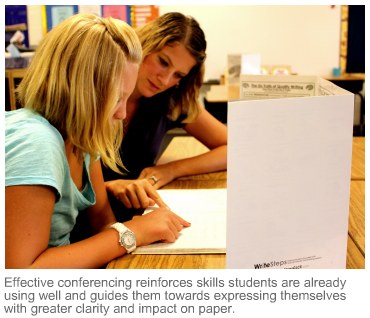
Because, unlike math or even spelling, writing offers no single correct answer. In some ways, it is like playing a sport. You have to put a variety of skills together to hit the target. As teachers, we demonstrate the “rules of the game” and then guide our students in strengthening their “performance.” It’s a step-by-step process. Like the coach who offers personalized advice to help each athlete improve, we give individualized feedback that helps students discover their power as writers.
In this three-part blog series, I discuss the most common conferencing challenges we hear about when coaching grade-level teachers on professional development days:
- The Old-Fashioned “English Teacher Mindset”
- I’m Not Sure What to Conference About
- My Class Gets Too Loud on Conference Days!
Let’s look at solutions for the first bullet point.
The Old-Fashioned English Teacher Mindset
Don’t take this the wrong way – English teachers aren’t the problem! The problem occurs when a teacher mistakenly corrects every single error on a child’s paper. Redlining papers like a high school English teacher does not serve K-5 writers! Why?
Just imagine this scenario. You are learning to play tennis. You’re a beginner who’s trying hard, and you’re proud of your efforts. Your coach offers feedback on your progress, and reports that you’re doing many things wrong. You need to: (1) follow through on your serves (2) use two hands for your backhand (3) adopt a different grip on the racket (4) plant your feet before every stroke, and (5) anticipate your opponent’s moves so you can hustle to the ball better. Sound overwhelming?
Solution — Don’t Try to Correct Every Mistake!
Nobody learns to play tennis like Serena Williams all at once. By the same token, children have a hard time maintaining motivation for the long haul if they’re faced with a long list of mistakes every time the teacher gives them feedback. In conferences, stick to one or two teaching points.
That’s all. Anything more, students will not absorb.
Tip: Your teaching points address writing weaknesses –but be sure to honor strengths, too! Just as none of us likes to hear a solid stream of criticism from colleagues or family members, students need their efforts acknowledged. When conferencing, compliment at least one specific strength for your two teaching points. WriteSteps students learn to analyze anonymous student writing samples this way, too, by looking for glows (what has the writer done well?) and grows (what could the writer improve?). The two must go hand-in-hand.
Did you find this conferencing tip helpful? If so, check back next week for part two of “Teaching Tips for Great Conferences with Elementary Writers” to learn what do to when you’re not exactly sure what to conference about! While you’re waiting for the next post, sign up for a free trial of WriteSteps, and discover why 1,000’s of teachers love our elementary writing program.

